Design And Performance Lab
Design And Performance Lab
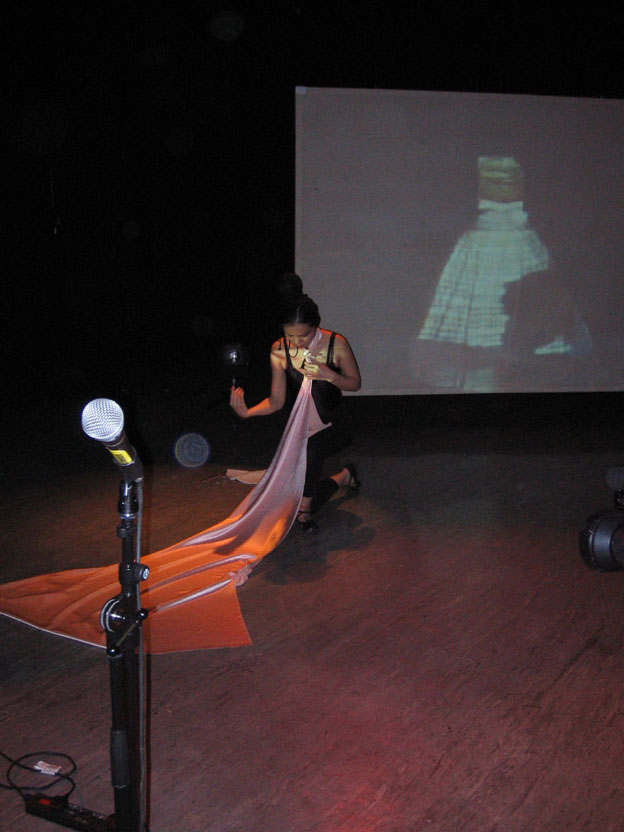
Spring 2005: Featuring designs by Michèle Danjoux, Jo Cope and Gemma Harrison.
Performance, film, photography and
digital audio-visual processing by Helenna Ren, Natasha Stott, Yoon Bo Shim,
Djuanita Soonpodra, and James Pearson.
Production director: Johannes Birringer
For the March 2005 "Telematic Dress" live event (click here)
The third phase (May 2005) expands the film and movement studies of the design-in-motion. It connects the research to telematics and live streaming media performance.
JOINT PERFORMANCE GALLERY: Live Event NOTTINGHAM, ROME, ARIZONA AND JAPAN (click here)
MAY 26-27, 8:30 pm GMT - 1:30 am GMT
Research development
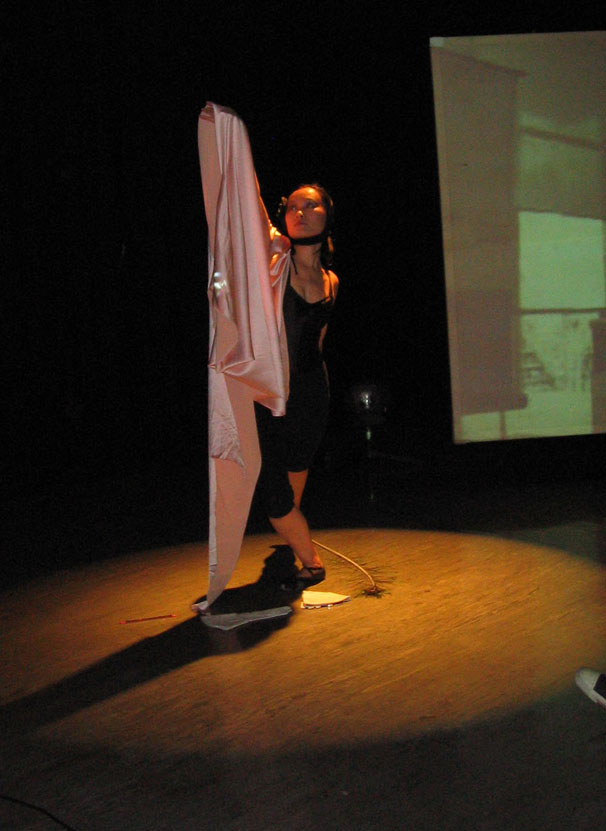
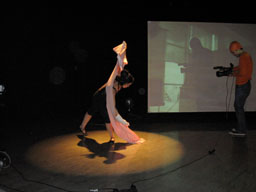
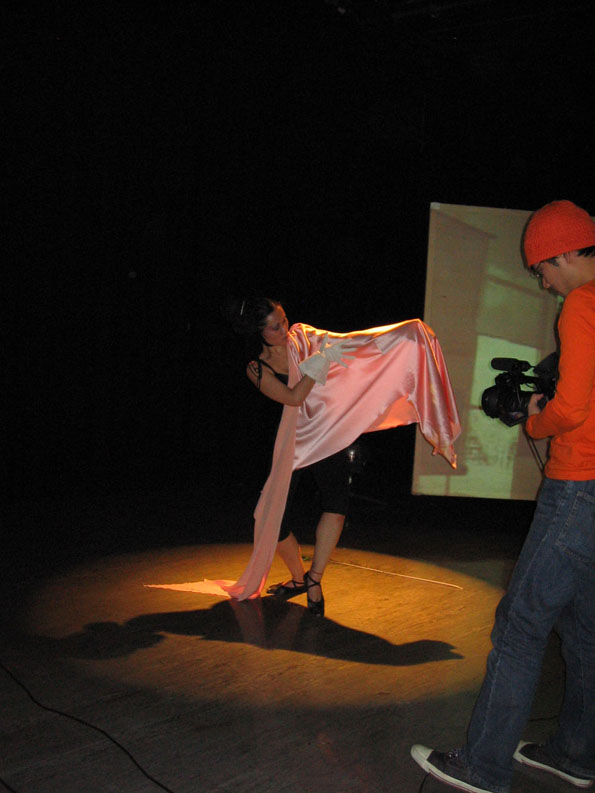
Helenna Ren (Nottingham) performing with Keira Hart (Arizona)
This cross-media lab explores convergences between textile/fashion design and movement, clothing and choreography, visual expression and film/photography, light and interactive design.
As an experimental process, participants explore the intimate relations between textures in motion, design ideas for fabrics and wearables, within a film and performance studio context which allows the clothes to be used for interaction with physical camera and real-time processing using digital software that respond to body movement and sensory processing. The multiple processes join skin and fabrics, color. sound, and visualization technologies.
Starting in the summer of 2005, Nottingham
DAPLab plans to start industrial collaboration with Canesis
Ltd (Little Lane, Ilkley, West Yorkshire) on the research and prototype
development of the "telematic dress" and other components of intelligent
fashion for bespoke high-performance clothing design.
Canesis Ltd - Innovative Technology Solutions and Services
Canesis Ltd offers unique innovative technology solutions and services to the European textile and related industries. Canesis is a world leader in applying science and engineering to the world of textiles for fashion and industrial applications.
Canesis Ltd is a subsidiary of Canesis
Network Ltd. Canesis Network Ltd has evolved from WRONZ, which has over
the last 40 years built an international reputation as a world-class provider
of research, development and technology services
* * *
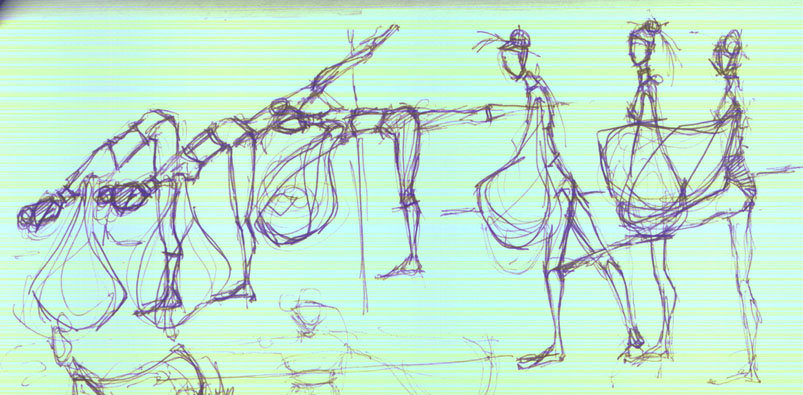
sketch for movement sequence (Michèle Danjoux)
Prototype 1
'Telematic Dress'
20/04/05 ADAPT
I am reading, drawing, sourcing fabrics, exploring hand/couture finishes
(for you to zoom in on with the camera), considering choreography.
The Telematic Piece (East and West/two sides):
First Piece:
I like the idea of 2 sleeves, (east/west influences, structured/partially
complete/incomplete) and 2 dancers. Each dancer would wear a sleeve and
the two could work together
Yellow, will be a link with the East and ancient tradition for one piece.
Second Piece:
Another piece (pink cloth), I will also introduce a new transparent texture
to it, a length of chiffon fabric. Unworked. This could echo Saeko's veil
(Tokyo performance) and allow the dancers in different sites to link in
some way. At some point another dancer/performer may enter the composition
(our side) and work with the first dancer (who has previously done solo
piece), wrapping her with the fabric, exploring form, texture etc on the
body. A kind of extension on from exploring things on one's own body.
The other body.
The head piece will have huge pins in it, a connection to the 'process'
of garment making and the beginnings of a process/seeds of an idea.
The pins are like acupuncture needles. Fragments of embroidery on an oriental
type collar will hint at tradition, time passing and decay (or construction/re-growth/formation).
Movements (the dancer), I hope will fuse East and West styles, classical
with contemporary, ballet with another (possibly Martial Art inspired).
A students of mine was explaining to me that many fencing poses have come
from classical ballet and indeed Karate movements are very akin to dance.
We shall look also at "House of Flying Daggers" again. (M Danjoux)
'Telematic Dress' 2
22/04/05 ADAPT
The ideas keep flooding in, my latest design is based around the whole 'labyrinth'
idea, which is talked about much in recent fashion writing/exhibitions.
The idea of the past existing very close to the present and to the future...
' Benjamin described how he once drew a diagram of his life as a labyrinth.
The metaphor of history as a labyrinth allows the juxtaposition of historical
images with contemporary ones; as the labyrinth doubles back on itself what
is most modern is revealed as also having a relation to what is most old.'
' The metaphor of historical time as a labyrinth or maze, doubling back
on itself, provides a model to understand the historical relay between past
and present in 1990's fashion....For despite fashion's insistence on innovation
and novelty, the historical trace/'complementarity with the past' persisted
in many designs of the late 1990's, constituting a network of historical
constellations in which past and present are telescoped together.'
( Fashion at the Edge. Caroline Evans. Yale University Press
2003.)
As an advancement on from my last thoughts email 20/04/05 'fuzzy thoughts',
I present to you the concept of the labyrinth.
'I have new thoughts/ideas connected with this whole 'memory' aspect (have
been studying Merleau-Ponty) and the creation of the 'telematic dress.'
It is difficult to represent memory and the past accurately, our brain compensates
and we remember from our position in the present/future. In terms of garments/dress,
I wonder about the design and the process of its creation or indeed the
state/partial state of its existence.
In the case of 'Victorian' dress, the Ariziona piece, the garment is the 'time traveller' and has many stories to tell, it exists in its finished well formed, fully resolved state.
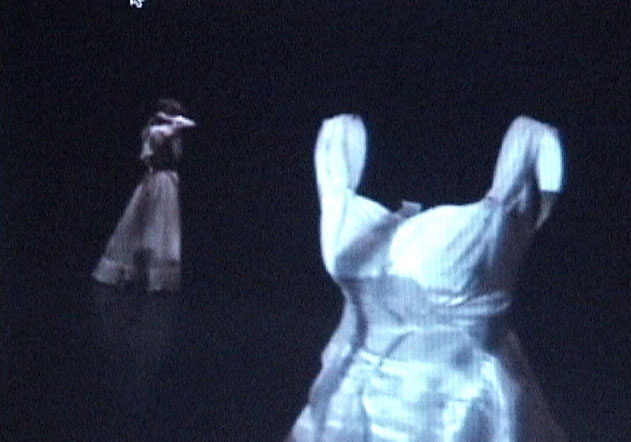
Keira Hart dancing "outside" the Victorian hoopdress (Arizona)
My piece exists in its developmental states/partial states, fragments from the past and the present (during the performance) and hints to the future. It is fluid and has the potential to react, can move and exist in different states, alters the pathways of memory, avoids predictable or predetermined solution. 'Genesis', I don't know, maybe I am not making sense right now, I need to consider this further.
My thoughts on this are just beginning to emerge, but I'm thinking that the dress should not emerge fully until the end of our telematic sessions. It will be created through ideas and movements/explorations that occur as a result of our link ups with other sites, (Japan, Brazil, Arizona). The 'Telematic Dress' will be the product of our connections and linking of ideas.'
20/04/05 'Fuzzy Thoughts'
The Labyrinth:
I imagine a piece that can morph/change/adapt, (throughout the live telematics
performance), a piece that maybe starts in one shape/form/place (ie. a Victorian
silhouette (as with ASU's piece), tied in and restricted, structured), but
can travel (through time across boundaries) to become something else at
another point or place, (i.e. a more fluid eastern inspired piece (link
with Saeko in Japan), where structure diminishes and fabrics unwind).
The fabrics used would be the same, but the arrangement and (in the case of the Victorian piece) the underpinning structures would change. For instance, the gathered overskirt becomes the veil, the bound in bodice, the expressive sleeve... The crinoline structure could be made of bodies, other performers who emerge from under the skirt to release the structure, change the shape. Hands/arms could wrap the body, indicating the corsetted restriction possibly.
The multiform body
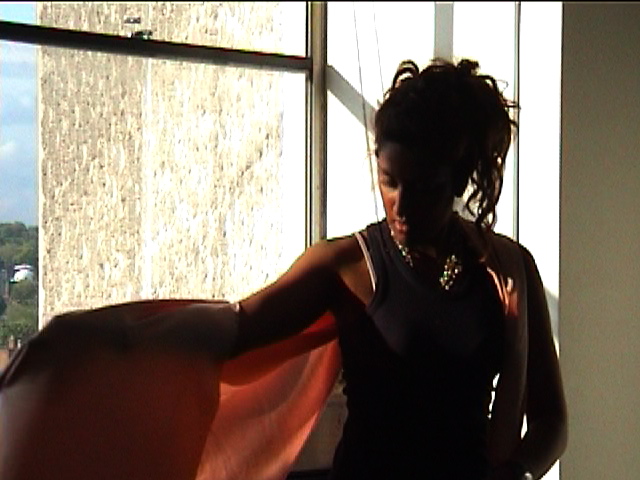
Djuanita Soonpodra
Our project is pure concept at this stage, and I will need to spend time
exploring the practical feasibility of this idea, how to get from one shape
to another through dance/performance and interaction with the fabric/pieces.
I liked Johanne' comments on 'self organising systems' within nature/artificial
life (email 22/04/05') and I think that there are many parallels to be explored
here.
The notion of auto poetic sounds interesting, perhaps you can talk to me
further on this. Perhaps the 'Labyrinth' suggestion is too 'predictable'
although, I would not be dealing with it in a necessarily predictable sense.
Needs to be explored.
N.B. Jo and Gemma may also have some prototype pieces ready for our telematics date in May. (Michele Danjoux)
Telematic Dress 3
CopeDesign rehearsal
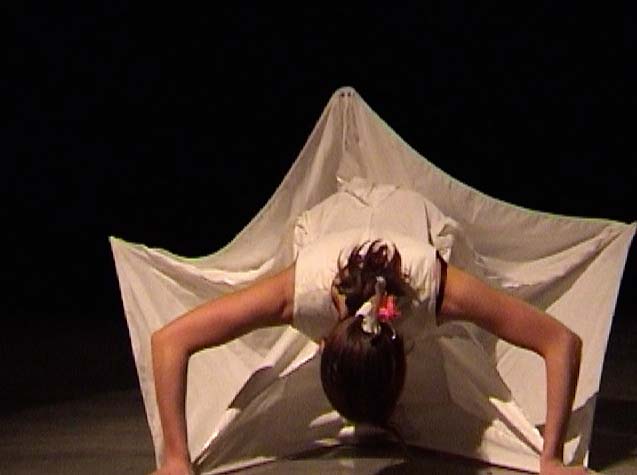
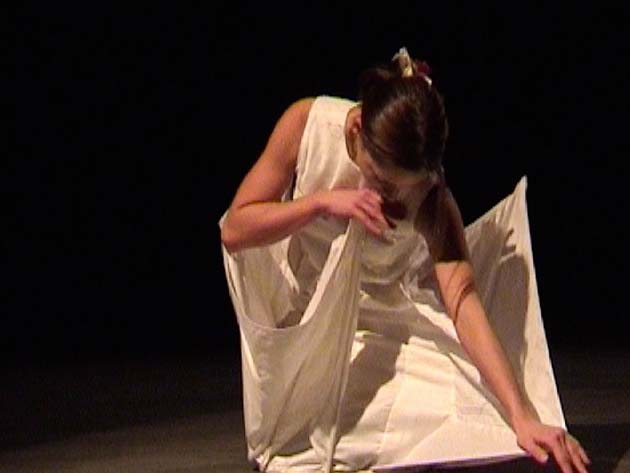
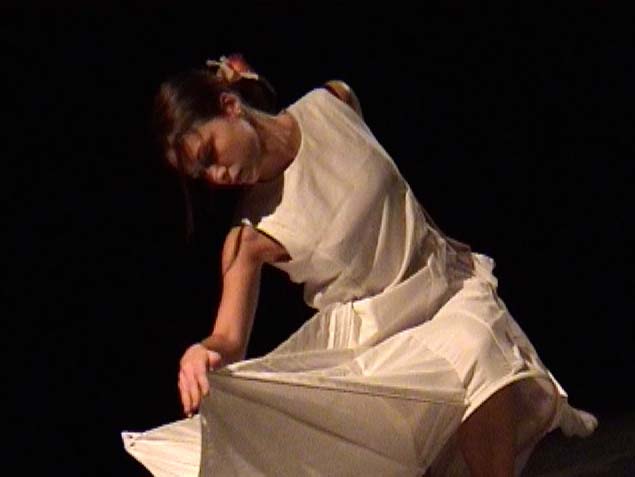
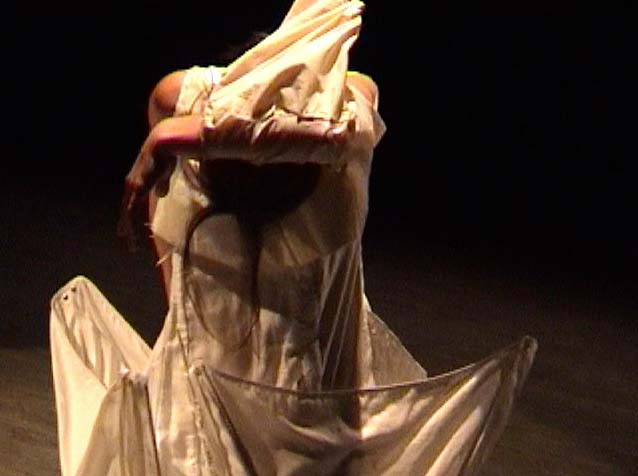
Natasha Stott performs with Copedesign
Jo Cope's rehearsal with Natasha explore the shape-shifting and shape-determining energy of a sculptural skirt and a one-sided sculptural sleeve. Some of the explorations of movement-design are influenced by concepts of the "puppet" and the "Ubermarionette."
The fabric of the sculpture skirt was first tested in film performance on the 5th floor of Victoria House in Nottingham, using extreme backlighting.
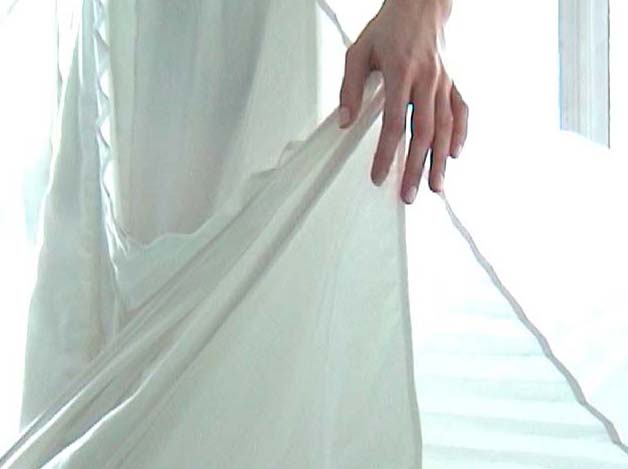
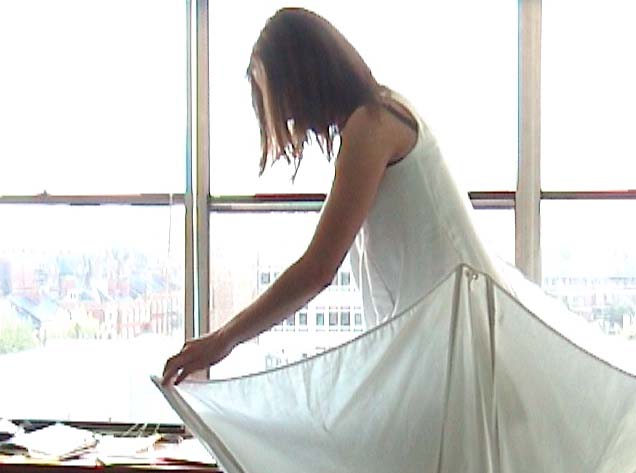
Response from Johannes Birringer (22/04/05)
I want to go back to your
first mail about sensual textures/qualities to interact with.
you said:
It is difficult to represent memory
and the past accurately, our brain
compensates and we remember from our position in the present/future. In
terms of garments/dress, I wonder about the design and the process of its
creation or indeed the state/partial state of its existence.
In the case of 'victorian' dress (Galina's piece), the garment is the 'time
traveller' and has many stories to tell, it exists in it's finished well
formed, fully resolved state...[The HOOP form, the "rings"
and its
historical-Victorian associations]
My piece exists in its developmental
states/partial states, fragments from
the past and the present (evolve in and during the performance) and hints
to
the future. It is fluid and has the potential to react, can move and exist
in different states, alters the pathways of memory, avoids predictable or
predetermined solution. 'Genesis', I don't know, maybe I am not making sense
right now, I need to consider this further.
(* the "autopoetic" dress:
the biological theories of self-organizing
systems or organisms work well with this idea of the "generative fabric
and
generative "text". See below)
My thoughts on this are just beginning
to emerge, but I'm thinking that the
dress should not emerge fully until the end of our telematic sessions. It
will be created through ideas and movements/explorations that occur as a
result of our link-ups with other sites, (Japan, Brazil, Arizona).
The 'Telematic Dress' will be the
product of our connections and linking of
ideas. (Michèle Danjoux)
Reply:
04-22
I think you are absolutely right about
these meanings and connotations of
memory and history, and the new dress as evolving and being distributed
in
constellation of process and becoming -- coming to the open, meaning also
coming beyond the open.
The open: reading your thoughts, my
spontaneous inclination was to think of Agamben's "open"
(Giorgio Agamben: "'TheOpen - Man and Animal') and link it with the
research on the
dance and neuroscience I was engaged in: it made me
read new biological and cognitive theories. Maturana and Varela are now
much liked by the current
generation of new media artists and digital artists woring with "systems"
in artificial life or modeling projects that involve digital VR works
modelled upon living systems.
The thinking that goes into the programming
or modeling is derived from
biology and what Maturana and Varela have described as auto-poetic
(self-organising systems) systems in the many species worlds and perceptual
worlds of our ecology of life forms in the largest sense, that is, any
species in the living organic world is - as a life form - organising itself
(and its survival) by adapting and adopting and by being in symbiosis with
other systems, this constitutes the intelligence of life forms of course,
even though the notion of "auto-poetic" systems also implies that
the perceptual world of a fly may be different from the perceptual world
of a airplane pilot. In that sense, the "auto-poetic system" is
like a closed perceptual machine that adapts to its own survival needs and
may not care about the survival needs of the other systems.
The system that grows and evolves is auto-poetic, and I know from some
dancers (colleagues such as Marlon Barrios Solano) that theythink of
interactive systems (impovised dance within intelligent environments, with
cameras, sensors, and computer softwares that "think") as such
open,
unpredictable and evolving systems. Interestingly, if one were to listen
to an artist/writer such as DJ Spooky, whose work with sampling and sound,
rhythms and remixes, has made him see "system" more through generations
of "rhythm," it would be fruitful to link the performative sensory
experience of "wearing" as evolving with the musical/rhythmic
idea, which also links to tyhe climatic and the seasonal, and the rhythms
of life and exposures (to our climates) which we ednure.
Your thoughts of the "open dress"
would go well with this process-idea of a
dress that is "genetic" (as you imply) and to some extent engineered,
by you
and the others who wear it and join the distributed design .
The question of where memory plays
across the surfaces need to be addressed
separately.
We (in Nottingham) did not use any
projections on top of the surface of the
fabric, but Helenna danced/manipulated the fabric. Now, the ASU-team was
projecting images on top of the "model" - and we would like to
hear again
what motivated the shot selection/image selection, how this image surface
was conceived, what was the contents, or can we speak of contents here (in
filmic terms), or do we have to formulate a new concept of image texture
(pattening) as a fabric design? What is a video-fabric design? How tactile
is it? Or is it meant to evoke the tactility i am refering to, or is it
mainly optical?
If it is optical (in the telematic
video sense), then how can a "distributed
dresss" , a telematic dress" become more open, more tactile? Does
not
projection foreclose? How can the dreass actually be more "worn"
or
experienced and manipulated by two or three dancers?
How is it "poetic"? to some
extent since it does function also within a
fictional and artistic universe created by the dancers and the teams, and
if we allow it to evolve without it being "predictable" -- in
the
distributed shared but not conclusive sense, yet symbiotically - then could
it also be considered auto-poetic? Does auto-generative here refer to the
biological intelligence, or is there an aesthetic dimensions, taking to
to
what Michèle refered to, the textile-connotations, color and shape
connotations, the design meanings, eastern, western and hybrid? But the
dress (unlike in Jane Harris's work of the floating digital
dresses-without-bodies), the dress is not dancing alone, it "is"
not alone.
There are dancers, in Arizona, Nottingham, Tokyio, and here it might be
interesting to think, for a moment, about "models" in the fashion
sense, and
in the dance sense, how do dancers model dresses in the open?
Johannes Birringer
15 May 2005
Subject: Corpos- telepresence performance at HTMlles festival on Friday, May 20th
We would like to invite you to join us at our performance in telelepresence
at HTMlles Festival(Montreal-Canada) on Friday, May 20th at 1 PM -
3 PM (EST Time). http://www.htmlles.net/07/en/index.html
http://www.htmlles.net/07/htmlles_comouv_e.html
We are going to be using IVisit, (www.ivisit.com)same room: Ivisit.net:
Arts/Creative/Corpos The theme of the performance is Crtl-C Ctrl-C
(Control-Copy/ Control-Copy).
Corpos Informáticos
Ctrl-C Ctrl- C is a telepresence
performance that
will discuss the possibility of poetic interaction in
telematic environment, the possibility of the absent
body to participate in effective aesthetic experience,
using the Internet as space of realization and the
public (on line and live audience) as co authors of
the work. Telepresence performance happen at the
World Wide Web: they are de-territorialized bodies,
reorganized (re-orphans) in monitors that are
dispersed in the world. The Internet, net of
communication, is in fact a net of information. In
telepresence performances subjectivities are connected
in real time, in actual communication; interlocution.
The Performance Art concept widens itself: an
ephemeral and presence oriented art; can it be
virtual? How much (or how much longer) is the spectral
body able to arouse emotion; affection? What is the
concept of "group" for the one who extends oneself and
becomes part of Internet community? The group work
that requires such openness of its members is now open
to numerous, numberless participants with different
perceptions of interlocution. This communication, a
truthful sharing, is it only an idea of encounter?
The Performance Art in telepresence is it an opening
for the body to became spectral? Or is it just
submission to the requirements of the machine?
Ctrl-C Ctrl-C is a event where artists in different
locations in Brazil, Montreal and the Internet
community will inter-act, towards the idea of the
presence itself, body mediated by technology, through
the Internet.
17 May 2005
ADAPT
"Ctrl-C Ctrl-C" promises to be an exciting event, and thank you for the descriptive text.
I wish I could take part, but Ii also wish to respond to the concepts, and again invite the others in our research group to respond to recent postings (Michèle/telematic dress) that we initiated on our process. I must insist that it is vital we continue/eleborate our research-investigation or we cannot function effeciently as a distributed research cooperative.
1. Ctrl-C.... ideas of interlocution--- and the connecting tissue (not-real
bodies, organs without bodies) of subjectivities:
.....are connected in real time, in
actual communication; interlocution.
The Performance Art concept widens itself: an ephemeral and presence oriented
art; can it be
virtual? How much (or how much longer) is the spectral body able to arouse
emotion; affection?
2. Yes, indeed, and I think the same question underlies the "telematic dress" project -- and the issue of an emergent dress that is co-authored through "use" and wearing, touching it and manipulating it. The dress is a more awkward proposition since, as we dress and wear something on our skins, we tend not to think of "dress" as virtual" but as very concrete.
3. the concrete dress, or fabric (design) taken up by the performer in Nottingham,
or the hoop dress that is inhabited by the performer in Arizona (while ephemeral
images, say, generated in Brazil or Japan percolate over its surface and
"sink" into its tactile texture).....or the veil worn by Saeko,
or the foot scanned in Brasil by Bia, these fabrics touching skin, hands,
faces, heads, shoulders, these feet, and the woman inside the video-hoop
feeling the light touch and careess her body.......this tactile and affective
(sensory) concreteness is lost when we imagine the "dress" to
become a connective tissue worn by two dancers in two remote sites?
One cannot wear a "distributed dress" -- perhaps the idea is nonsense. Two remote dancers can wear fabrics on their end, on either site. They can also look at each other's streaming video, their sounds, and (in transports that include tactile data) they could "sense" each other's energies or motion or "use" of fabric if indeed the woven fabric were sensitized (with data-transmitting sensors), as it is being developed in some cases (colleagues like Yacov Sharir/Barbara Layne, Joanna Berezowska), and as we are trying to develop an intelligent fabric design here that would make sense to someone on earth (not virtual space).
On earth: we need sensing.
4. The notion of inter-face-dressing or wearing a telematic dress that is emerging through shared/joint manipulation and performance --- the emergent dress, here I used the question about the "auto-poetic": in a recent mail -- my apologies, it was a factual error, the theory of self-generative systems and organisms actually implies a notion (based on Aristotle) which is called "auto-poiesis", which is not quite the same as auto-poetic.
So my question should not have been,
where is the poetry of this non-tangible inter-locution, between Helenna,
Keira and Saeko --- but in our conception and dramatury of telematic performance
with dress, where is the auto-poiesis of the fabric shapes and affects and
meanings, where is the auto-generative creation of something that could
be worn in more than place, by more than one person, a community, a group,
a couple? where is such parangolés that could allow Keira to dance
with the dress that Helenna has picked up, holds on her right side and then
moves with, for keira to put on and wind and stretch and transform back
for Helenna to see/feel and experience?
Analysis/Critique:
March 17-18 online event:
1. our camera work in relation to dancer manipulating dress was not exactly choreographed or developed with a storyboard at hand, so that relations to subject in the frame were in-coherent. No emphases, in framing and composition, were achieved, so that details (in image), closeness/proximity, distance, shape and effect could be transmitted in the live stream.
Since we improvised, the camera work
stayed at relative/same distance, to whole dancer body, rather than to the
fabric, a hand, the head or face, the shoulder, arm, foot.....
dress fragment or "part object" and body-part were not highlighted
nor motivated. Our performance became an improv- dance, not a telematic
(tele-focussed) composition-in-progress. There was little structure.
2. The medium range filming of Helenna's dance with the dress stayed on a samle level for a long duration, that sameness lost effect. We did not introduce, in this first joint performance, a time dramaturgy (say, working with shorter segments (3 minutes, then black out), and then change camera angle or focus) -- we did not work on the temporal nature of the poiesis.
3. The sites were not linked in such a way that an "inter-locution" between Helenna and Keira was achieved. The two dancers in remote location danced with their own fabrics, but not with each other's fabric, and could not exchange the sensations with which the image and the "design" composed itself over time., sensing each other. They barely knew each other (any better after an hour, which should happen when you do contact work for an hour).
4. How do we feel the movement (and wearing the fabric) of the other?
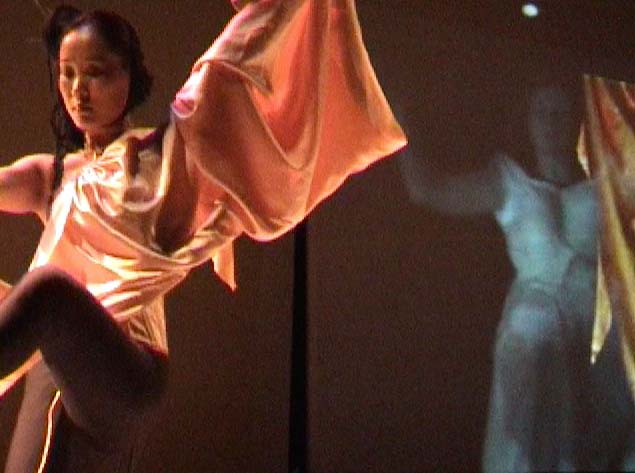
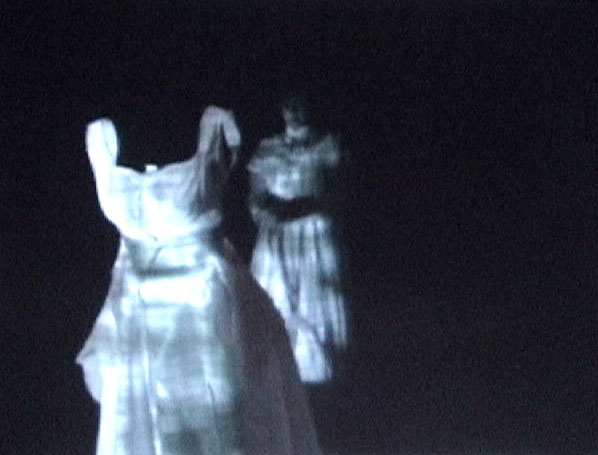
Helenna (left, onstage in Nottingham) and Keira (middlescreen, with Helenna-sleeve) (Keira, right on stage in Arizona)
5. Transmission of sensory data has not been established yet, nor did we , on our end, succeed spatially with a super-position of the images/site-streams, so that we remained separated. In think ASU's hoop dress accrued more combinatory possibilities, through the projection of images (generated, received) onto the surface of the "historical dress" - but how rich in memory or association could it become to be perceivable, since, as i pointed out, projection onto surface and then re-transmitting (video of videoprojection) tends to thin out the image, make it feeble, pale.. We have no high contrast, and no high energy, like the pulsating effect that you might feel when you see a dress or fabric become wet or unravel or motion on/with moving body on the dance floor. When a dress begins to "stick" to you.
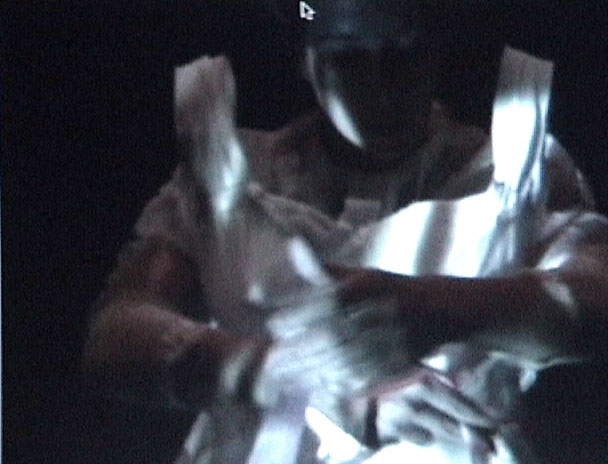
Keira re-entering the Victorian dress
6. Our designers point out that one important aesthetic function of design is to decide where to place the energy on the body, where to focus with the design on a particular area of the body, And how to achieve a one-ness of movement and structure. Or transformation of BODY through FABRIC? When we inhabit a dress or feel it move along with us, how can this experience be "distributed?
Johannes Birringer
THE NEXT JOINT PERFORMANCE BETWEEN NOTTINGHAM, ARIZONA AND JAPAN IS ON THURSDAY, MAY 26, 9:30 pm GMT - 1:30 am GMT
LInk up with Rome (Emiliano Campagnela) www.vite3.it : 9pm GMT / 22h
Link up with Arizona: 11:00 pm GMT / 4 pm MST
Link up with Tokyo: 1:oo am GMT
Further notes on design and performance concepts will be published on this site.
Project directors: Johannes Birringer & Michèle Danjoux
Brunel University, West London